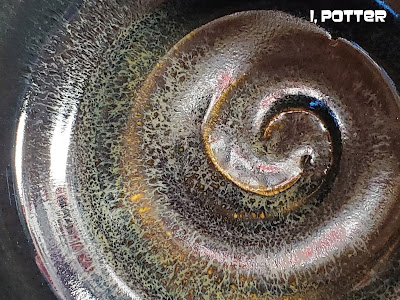This
is a classic example of one of Kohyama's highly animated and lively tokkuri
with a rich array of ash effects creating three distinct zones of color and
texture on the face of the pot accompanied by a simple guinomi with an inviting
posture and spirited form. One aspect of this photo captures the wonderful
shadowed area at the base of each piece, in many respects it almost appears
like the pots are hovering, detached from the surface they are resting on.
Despite the simplicity of these two pieces both tokkuri and guinomi show a well
defined use of the details making for a rather unique and conscious pot based
on years of experience, trial and error and a unique understanding of the
Shigaraki tradition, its materials and firing to created objects formed and even
sliced from the earth.
Friday, October 30, 2020
WHILE I WAS THERE
Wednesday, October 28, 2020
DNA
Making wonderful use of the marriage of shape and surface this chawan was carefully manipulated to create a more dramatic effect and just the right amount of movement that brings a pot to life. I find this chawan pleasing to the eye and hand with a soft, blushed color that in some respects reminds me of a winter trying to hang on while the spring is in a hurry to take over. It is hard not to enjoy the narratives that Tsukigata paints on the surface of his pots substituting clay, glaze and fire for oils and canvas, either way, it paints a rich portrait that brings more depth of meaning to such a simple teabowl.
Monday, October 26, 2020
BLUE BOWL
Friday, October 23, 2020
WARMING UP
Wednesday, October 21, 2020
TAMBA FUTAMONO
Monday, October 19, 2020
A "B" FOR EFFORT
Both survived and didn't stick to the protective shelf pieces they were fired on (!) and once cool I gave them both the pour test. In truth, I think I would give them a solid B for their performance as due to the small aperture where the spout meets the body of the ewer, the air exchange is a bit restricted leading to some "glugging" to occur unless the pour was held just right and done slowly. I would love to say they both got an A+ but they do function, fit well in the hand and look okay in the process. What's next, maybe triangular of square ewers, I guess it depends on the day and the music!
Friday, October 16, 2020
CLASSIC TAMBA
Wednesday, October 14, 2020
THREE YEARS BUT WHO'S COUNTING
As for the chawan, it was made by Koyama
Naohiko, son of Koyama Kiyoko and though on the small side it packs quite a
visual punch. Obviously well fired and in a rather desirable spot in the kiln,
the velocity and ferocity (no not twins from P&TNPG) is written like a good
novel across the surface of the bowl with the ash frozen in motion and
culminating in a near flawless emerald gen-like drip on the reverse (see
detail). The chawan was fired on its side at an angle as indicated by the shell
scars which add volumes to the surface. I am hoping it doesn't take me another
few years to get a slideshow video made for this Koyama chawan as I think it is
worth seeing to get the fullest picture of the piece, maybe in a couple of
weeks.
Monday, October 12, 2020
TC SQUARED
Friday, October 9, 2020
QUIET BOWL
I had this simple, quiet Shino chawan here for a while and have to admit, though it doesn't scream its presence there is a comfortable, contemplative atmosphere related to the bowl. As I think back on the time spent with the teabowl it was always easy to envision it in use, how it presented itself in rest and how it felt in the hand, there is nothing challenging about the form, surface or foot but the backdrop is surely use. I built this short video slideshow to give a better insight in to this Arimoto Kugen chawan from as many angles as possible which hopefully shares my impressions of the chawan despite the chawan not being not filled with tea on your table.











